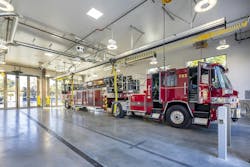Today, some things from 1975 might be considered vintage, such as disco, bell-bottoms and station wagons with wood paneling. Other things haven’t found another life: for instance, 8-track players and rotary phones. OK, maybe station wagons with wood paneling, too.
Because essential services facilities ideally are built with a lifespan of 50 years, fire stations that were built before 1975 are among those items that have become “old” rather than “vintage.”
With rapid advancements in technology, sustainability and best practices for fire personnel health and safety, station designs from even the past 10 years evolved drastically. Although we know that departments can’t update their stations with every industry trend that arises, there comes a time when a department can’t afford to continue to operate out of an outdated facility.
For those who live in the facility day to day, this time often is apparent. Cramped bunkrooms, apparatus bays that aren’t large enough to support new apparatus, and a lack of gender-inclusive spaces can be obvious. Some necessary updates might not be as visible, such as poor air circulation, lack of best Hot Zone design practices and failing infrastructure. Not only can these items impede service to the community, but they put the health and wellness of fire personnel at risk.
In some cases, a station renovation is sufficient to serve a department’s immediate needs and the budget that’s available to it. In other circumstances, a replacement of the station is the only viable solution to provide a state-of-the-art space for fire personnel.
Indications
Signals that your station is fit to be replaced include:
- The station doesn’t meet best practices for Hot/Warm/Cold Zone design.
- There’s a desire to incorporate more sustainable and/or all-electric features.
- The department and crew will grow significantly in the next 10 years.
- The station doesn’t comply with current building codes, including design to meet essential services requirements.
Because the cost of new construction can be a deterrent to replacing a station, it often is necessary to develop creative design solutions to work within budgetary constraints. Choosing between a renovation or a replacement requires a detailed discussion of the cost-benefit of renovating the shell of what exists versus the long-term functional and operational benefits of building new. In many cases, the cost of renovation approaches the cost of replacement. In those cases, replacing the station might make the most sense.
A case study
A feasibility and needs assessment analysis for the Livermore-Pleasanton, CA, Fire Department’s (LPFD) aging Fire Station 3 was conducted. Items that were analyzed included the potential for a renovation; seismic upgrades; mechanical, electrical and plumbing systems; roofing, doors and windows; flooring; energy-efficiency modifications; apparatus bay enhancement; living quarters; and Americans with Disabilities Act and safety modifications. The assessment led to the decision that an immediate replacement of the station would be the best choice for the future of the department and the surrounding community.
The aging infrastructure wasn’t capable of supporting the extent of renovations that would be necessary to bring the station up to usable conditions. Moreover, the estimated cost of attempting to renovate the station would have approached or exceeded the cost of a replacement.
With a full replacement, programming and a facility layout that would best support the department into the future were created.
Time to replace your station?
If your aging station no longer meets the needs of your department, it’s essential to determine whether the building is capable of supporting extensive renovations or a replacement of the facility better serves long-term needs. This process can be approached in two ways. The design team can “budget to a design” or “design to a budget.” In the first case, you must determine what the overall best solution is and obtain a cost estimate that’s reflective of that scope of work. In the second case, you must be provided with a scope that fits within the identified budget.
Replacing an old station with a new facility allows a department to recognize the benefit of the most logical site layout and accommodate future growth needs. If you believe that your station might need to be replaced, the following steps are recommended:
- Hire a qualified design team that has experience in the design of new and renovated fire stations.
- Perform a full assessment of your existing facility.
- Develop concept sketches for renovation and/or replacement.
- Develop cost estimates for each option.
- Present the pros and cons of each.
- Decide which option will best support the department for the next 30–50 years.

Jeff Katz
Jeff Katz is the principal of COAR Design Group, which has more than 33 years' experience in designing public safety facilities, including fire stations, fire headquarters, emergency operations centers and training facilities. He has been the principal-in-charge on several award-winning fire station projects, including ones that were recognized as Gold, Silver and Bronze projects by Firehouse’s Station Design Award committee. Katz completed several LEED-certified fire station projects and is working on numerous fire station and training facility projects throughout the state of California.






